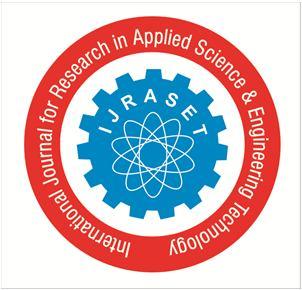

Study of Temperature Sensor (TMP139) based on I3C Interface


Manjiri Kulkarni1, Dr S P Meharunnisa2 1, 2Dept of EIE, DSCE, Bengaluru, India

Abstract: In the current digital world with all smart and compact devices, the monitoring and controlling aspects of device parameters is a crucial role. One such crucial parameter for a digital device is the heating of the device and its maintenance. Temperature sensors come into the picture for such controlling and monitoring applications, for example, in devices like laptops, handheld phones, SSD, and many other industrial devices. A temperature sensor with a high accuracy rate is introduced by Texas Instruments called TMP139, which uses the latest I3C protocol for its function. This paper relates to a study of this sensor that is compatible with the I3C protocol.
Keywords: I3C, Temperature sensor, TMP139, Thermistors

I. INTRODUCTION
Let’s look at an example to get to know about temperature sensors. When you leave your phone in the car for a prolonged period of time, it automatically gets heated and this is sensed and indicated on the screen. This is due to your phone's internal temperature being measured by a little embedded temperature sensor. This temperature sensor transmits an electronic signal to an embedded computer once the inside of the phone reaches a specific temperature, so that to refrain the users from using any applications or features until the phone has cooled down to a normal bearable temperature.

The TMP139 is a contact type temperature sensor which uses a thermistor for heat detection in the devices and industrial machinery. There can be many varieties of thermistor available in the market to choose from. This choice depends on certain application specific parameters such as BOM(Bill of material) Cost, resistance tolerance of the thermistor, sensitivity, self heating, sensor drift, calibration point and so on.
II. DESCRIPTION OF TMP139 IN COMPATIBILITY WITH I3C
The TMP139 is a high accuracy thermal temperature sensor capable of being powered on, powered off, and reset. It also supports parity error check and packet error check features, standard common command codes (CCC) & In Band Interrupts (IBI).
When
B. Attributes
Technology (IJRASET
ISSN: 2321 9653; IC Value: 45.98; SJ Impact Factor: 7.538

10 Issue IX Sep 2022 Available at www.ijraset.com
of 1.8 V
an I/O
1) TMP139 supports JEDEC JESD (an international business organisation that creates common standards for microelectronics) grade B Temp sensor.
2) Bus reset mechanism this feature prevents a device from locking up the serial bus.
3) Parity error checking TMP139 implements odd parity. The parity error check is supported in I3C mode for both CCC and host to device data transfers. Only when the host writes to the disc does the parity bit get delivered, and the TMP139 must verify the parity to confirm that the information or CCC it has received is accurate. The system uses odd parity. The parity bit is set to 0 if an odd number of bytes inside the byte are set to 1. The parity bit is set to 1 if an even number of bits in the byte are set to 1.
4) Packet error checking This is only supported in I3C mode. The device location, the R/W bit, and the data packet are used to compute the PEC, which is only supported in I3C mode. On a START or Repeat START bus condition, the PEC function's seed value is reset to zero. It is carried out at CRC 8.
C. Functional Attributes

1) Basic I3C Mode operation This mode is initiated via I2C mode only. In this particular operation mode, along with SDA Driver (push pull type) the data transfer takes place at 12.5Mhz. I3C operation supports below parameters by default or when they are enabled.
2) The In Band Interrupt function needs to be enabled once in the I3C mode. This can only enable when the TMP139 bus is not active for a certain period of time. To denote this the sensor bus pulls the SDA line to low, showing the request for IBI from the host.
3) PEC (Packet error check) is to be enabled by the master in this mode.
s 1 1 1 1 1 1 0 r/w=0 ack
sr 0 Sa 1 0 Hid2 Hid1 Hid0 r/w=0 Ack/nack
PEC T s/sr Fig 2. Write in I3c (with PEC and IBI header)
4) The one function that is always enabled is the Parity Check function.
5) Support for a subset of CCC which are enlisted under I3C specs In TMP139 both the direct and broadcast CCC messages are validated. One direct ccc can be received after another direct ccc along with a repeated start condition, same goes with the broadcast ccc message. Every ccc mode operation is validated only when the required master sends 7’H7e along with read/Write bit.
supported CCC in the TMP139 are SETAASA(switches back to I3C basic mode from I2C mode), DEVCAP(other device capabilities), ENEC (enables initiation of event interruption), DISEC (disables the initiation of event interruption), DEVCTRL(controls enabling and disabling of device operations), RSTDAA (switches to I2C mode from I3C basic mode), GETSTATUS( issued to get if any status is pending in parity error), etc.
operation can either be push pull or open drain in a basic I3c mode.
additional bonus of I3c interface in the TMP139 ensures the potential to dynamically adapt the device to serial address.
III. SUMMARY
proofing of the design with user friendly interface , increased accuracy of TMP139 temperature sensor features and showcases integrated I3C bus compatibility, customizable address, IBI and improved efficiency.
REFERENCES
Amit Ashara. (2021). Enhance Thermal Sensing Performance With I3C Bus. Texas Instruments, 2.
https://e2e.ti.com/support/sensors group/sensors/f/sensors forum/980546/faq tmp139 can i use tmp139 with a mipi i3c controller
https://www.mouser.in/new/texas instruments/ti tmp139 digital temperature sensor/
ISSN: 2321 9653; IC Value: 45.98; SJ Impact Factor: 7.538

10 Issue IX Sep 2022 Available at www.ijraset.com
[4] TMP139
[5] https://www.watelectronics.com/i3c
[6] https://www.jedec.org/document_search?search_api_views_fulltext=jesd
[7] https://www.watelectronics.com/temperature sensor/
https://www.fierceelectronics.com/sensors/what a temperature sensor#:~:text=A%20temperature%20sensor%20is%20an,different%20types%20of%20temperature%20sensors.
[9] https://e2e.ti.com/support/sensors group/sensors/f/sensors forum/980546/faq
mipi


